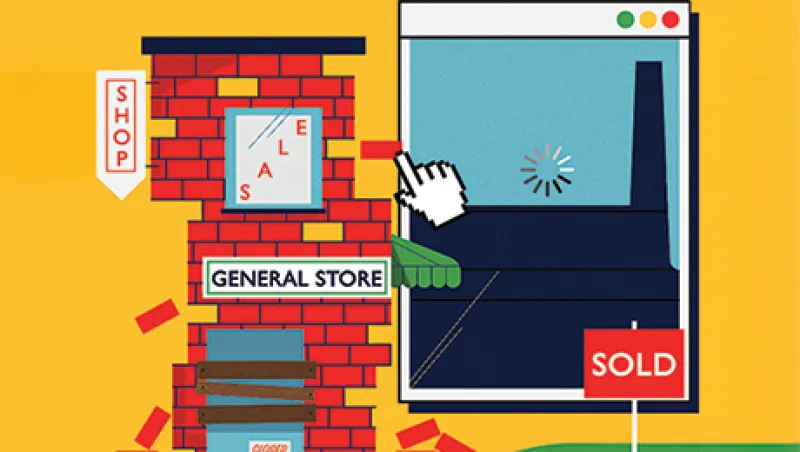In the real estate market, is there a law of conservation of brick and mortar akin to chemistry’s law of conservation of mass?
That question arises as the surge of online retail sales gives a strong boost to industrial real estate. At the same time, many brick-and-mortar stores are closing. “This is the ultimate irony,” says Eric Frankel, an analyst for real estate research firm Green Street Advisors in Newport Beach, California.
The strength of industrial real estate shines clearly in the performance of real estate investment trusts. In 2016 the FTSE NAREIT index of industrial REITs produced a whopping 30.7 percent return, compared to just 0.95 percent for retail REITs and 8.6 percent for REITs as a whole.
Soaring web sales translate into an increased need for warehouses to store and distribute the goods being purchased, paving the way for industrial real estate’s rally. Online retail sales totaled $101 billion in the third quarter, up 16 percent from a year earlier, accounting for 8.4 percent of total sales, according to the Commerce Department.
Prologis, the largest industrial REIT, has calculated that every dollar of online sales requires three times more distribution and warehouse space than a dollar of sales at a brick-and-mortar store. That’s because a shipment of goods to a brick-and-mortar retailer is usually large, unlike the huge number of small shipments going to individuals. Internet sales routinely involve the delivery of a single package to anywhere in the country and beyond. Often these goods travel long distances before reaching their endpoint and must be stored in industrial facilities along the way.
Demand from Internet retailers for industrial space is particularly strong for “last-mile” locations near customers who demand overnight or one- to three-day delivery, real estate analysts say. “Last-mile distribution is the silver bullet that everyone is trying to figure out,” says Jonathan Miniman, a portfolio manager at CBRE Clarion Securities in Radnor, Pennsylvania.
Small warehouses are desirable to meet consumer demand for same-day deliveries, says James Sullivan, a REIT analyst at BTIG. And warehouses are cropping up near population centers – in places such as Hoboken and Bayonne, New Jersey – to keep the impatient customer satisfied.
Amazon.com is the big gorilla of online retail tenants in terms of demand for industrial space, ranking No. 1 among Prologis’ tenants of any type and representing 3.1 percent of its net effective rent. Delivery service DHL is No. 2 at 1.6 percent, with some of its business tied to online retail sales. Brick-and-mortar retailers with a substantial online presence are also big industrial real estate tenants. Walmart is No. 9 at 0.8 percent, and Best Buy is No. 22 at 0.3 percent.
“Other retailers want to compete with Amazon, and it’s hard to do that when you’re shipping goods out the back door of your stores,” Sullivan says. “There is increasing investment in direct-to-consumer sales. As the online share of retailing grows, there is just more of a need for industrial real estate for retailers to meet their needs.”
Green Street estimates online sales boosted industrial real estate demand 30 to 40 percent last year, and analysts expect the boom to persist. “Occupancy and rent growth are at historical highs” in the sector, notes Edward Mui, a real estate analyst at Morningstar, a research firm in Chicago. “We expect this trend to continue in the foreseeable future, as online sales continue to grow faster than brick-and-mortar.” Average industrial rents rose 6 percent last year, the steepest increase in 17 years, according to Green Street. And the property availability rate dipped to 8.2 percent, the lowest in 15 years, according to CBRE.
While industrial real estate is booming, retail real estate is sagging, as venerated companies such as Macy’s, Sears, and The Limited are closing stores. “Average and lower-quality malls are getting hurt,” Sullivan says. So the subpar performance of retail REITs is no surprise.
As for industrial real estate, while the outlook remains bright, there are some reasons for caution, analysts say. “Investors are concerned about too much supply growth of industrial space, and that concern is justified because industrial product can be built quickly,” Sullivan says. “But demand is a secular phenomenon, which is swamping supply now. Supply is being absorbed quickly at high rents.”
Green Street’s Frankel says supply will probably catch up with demand soon, lowering rent increases but leaving them higher than the rate of inflation.
Miniman says there is a risk of oversupply, which occurred quickly in the last real estate cycle. “But it looks better this time around: capital is more disciplined, so hopefully the cycle will continue longer.”
Thus it appears that the ascent of brick-and-mortar industrial real estate will continue to compensate for the decline of brick-and-mortar retail real estate.







